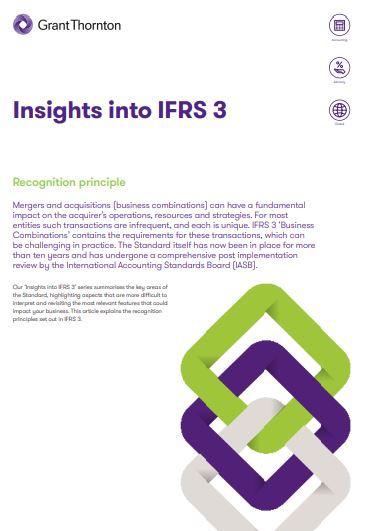-
Business Risk Services
Our Business Risk Services team deliver practical and pragmatic solutions that support clients in growing and protecting the inherent value of their businesses.
-
Corporate Finance and Deal Advisory
We offer a dedicated team of experienced individuals with a focus on successfully executing transactions for corporates and financial institutions. We offer an…
-
Economic Advisory
Our all-island Economics Advisory team combines expertise in economics and business with a wealth of experience across the public and private sectors.
-
Forensic Accounting
We have a different way of doing business by delivering real insight through a combination of technical rigour, commercial experience and intuitive judgment. We take…
-
People and Change Consulting
The Grant Thornton People & Change Consulting practice works with clients on these issues as well as on all aspects of how they attract, retain, engage develop, deploy and…
-
Restructuring
We work with a wide variety of clients and stakeholders such as high street banks, private equity funds, directors, government agencies and creditors to implement…
-
Technology Consulting
Motivating and assisting our clients to pursue, maintain and secure the benefits of digital solutions is at the core of our Digital Transformation teams' agenda and goals. We…

-
 Audit and Assurance FRS 102 Periodic Review Series – Other changesOn 27 March 2024, the Financial Reporting Council issued amendments to FRS 100 – 105 (known as GAAP, or Generally Accepted Accounting Practice), a suite of accounting standards applicable in the UK and Ireland. These are used by an estimated 3.4 million businesses in preparing their financial statements.
Audit and Assurance FRS 102 Periodic Review Series – Other changesOn 27 March 2024, the Financial Reporting Council issued amendments to FRS 100 – 105 (known as GAAP, or Generally Accepted Accounting Practice), a suite of accounting standards applicable in the UK and Ireland. These are used by an estimated 3.4 million businesses in preparing their financial statements. -
 Audit and Assurance ID Verification: Economic Crime & Corporate Transparency Act 2023Companies House is introducing mandatory identity verification requirements for Directors and People with Significant Control (PSCs), as the next step towards full implementation of the Economic Crime and Corporate Transparency Act 2023.
Audit and Assurance ID Verification: Economic Crime & Corporate Transparency Act 2023Companies House is introducing mandatory identity verification requirements for Directors and People with Significant Control (PSCs), as the next step towards full implementation of the Economic Crime and Corporate Transparency Act 2023. -
 Audit and Assurance FRS 102 Periodic Review Series – Accounting for LeasesOn 27 March 2024, the Financial Reporting Council issued amendments to FRS 100 – 105 (known as GAAP, or Generally Accepted Accounting Practice), a suite of accounting standards applicable in the UK and Ireland. These are used by an estimated 3.4 million businesses in preparing their financial statements.
Audit and Assurance FRS 102 Periodic Review Series – Accounting for LeasesOn 27 March 2024, the Financial Reporting Council issued amendments to FRS 100 – 105 (known as GAAP, or Generally Accepted Accounting Practice), a suite of accounting standards applicable in the UK and Ireland. These are used by an estimated 3.4 million businesses in preparing their financial statements. -
 Article Changes to company size thresholds in the UKOn 10 December 2025 the UK Government laid The Companies (Accounts and Reports) (Amendment and Transitional Provision) Regulations 2024, which will take effect on 6 April 2025.
Article Changes to company size thresholds in the UKOn 10 December 2025 the UK Government laid The Companies (Accounts and Reports) (Amendment and Transitional Provision) Regulations 2024, which will take effect on 6 April 2025.
-
Corporate and International Tax
Northern Ireland businesses face further challenges as they operate in the only part of the UK that has a land border with a country offering a lower tax rate.
-
Employer Solutions
Our team specialises in remuneration and incentive planning and works closely with employers, shareholders and employees to ensure that business strategies are…
-
Entrepreneur and Private Client Taxes
Our team of experienced advisors are on hand to guide you through any decision or transaction ranging from the establishment of new business ventures, to realising…
-
Global Mobility Services
Grant Thornton Ireland offer a different approach to managing global mobility. We have brought together specialists from our tax, global payroll, people and…
-
Outsourced Payroll
Our outsourced service provides valued service to over 150 separate PAYE schemes. These ranging from 1 to 1000 employees, working for micro, SME and global…
-
Tax Disputes and Investigations
Our Tax Disputes and Investigation team is made up of tax experts and former HMRC investigators who have years of experience in dealing with a variety of tax…
-
VAT and Indirect Taxes
At Grant Thornton (NI) LLP, our team helps Northern Ireland businesses manage their UK and global indirect tax risks which, as transactional taxes, can quickly…


For most entities such transactions are infrequent, and each is unique. IFRS 3 ‘Business Combinations’ contains the requirements for these transactions, which can be challenging in practice. The Standard itself has now been in place for more than ten years and has undergone a comprehensive post implementation review by the International Accounting Standards Board (IASB).
Our ‘Insights into IFRS 3’ series summarises the key areas of the Standard, highlighting aspects that are more difficult to interpret and revisiting the most relevant features that could impact your business. This article explains the recognition principles set out in IFRS 3.
Overview of IFRS 3’s recognition and measurement principles
The acquisition method requires the acquirer, to recognise and measure the acquiree’s identifiable assets acquired and liabilities assumed at their acquisition-date fair values, subject to some exceptions. These assets and liabilities usually include assets and liabilities already reported in the acquiree’s financial statements. Applying the acquisition method may, however, also result in recognising assets and liabilities that were not previously reported in the acquiree’s financial statements for instance a brand name, a patent or a customer relationship, as the acquiree developed them internally. IFRS 3’s recognition and measurement principles should be applied to determine which assets and liabilities to recognise and how they should be measured. The identifiable assets acquired and liabilities assumed should consist of those that:
- belong to the acquiree at the date of acquisition, and;
- form part of what has been acquired by the acquirer.
Most, but not quite all, of these assets and liabilities are measured at fair value at the acquisition date – the so called ‘fair value exercise’. (The term ‘purchase price allocation’ is still frequently used to describe this process although it does not perfectly align with the IFRS 3 accounting model). This fair value exercise is usually a complex and time consuming step in accounting for a business combination. Many entities engage outside specialists in the valuation area to provide assistance. In most cases this step requires a good knowledge of the business acquired, careful analysis, extensive use of estimates and management judgement in a number of areas.
Practical insight
-
The objective of this exercise is to identify the main items for which the acquirer made the decision to purchase the business. Establishing the core reasons for making the purchase should help to identify the intangible assets acquired, that is, what did the acquirer get in return for the consideration paid and what they were willing to pay for? For example, was it to gain access to a specific technology, to acquire a trademark with a market share (this is usually associated with a technology, a know-how or a process)?
Refer to our article ‘Insights into IFRS 3 – How should the identifiable assets and liabilities be measured?’ for more details on the fair value exercise.
In an acknowledgement of these challenges, IFRS 3 allows a ‘measurement period’ of up to twelve months from the date of acquisition for the acquirer to complete the initial accounting for the business combination.
Update your subscriptions for Grant Thornton publications and events.













